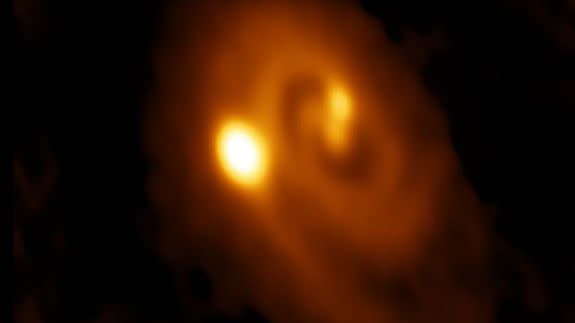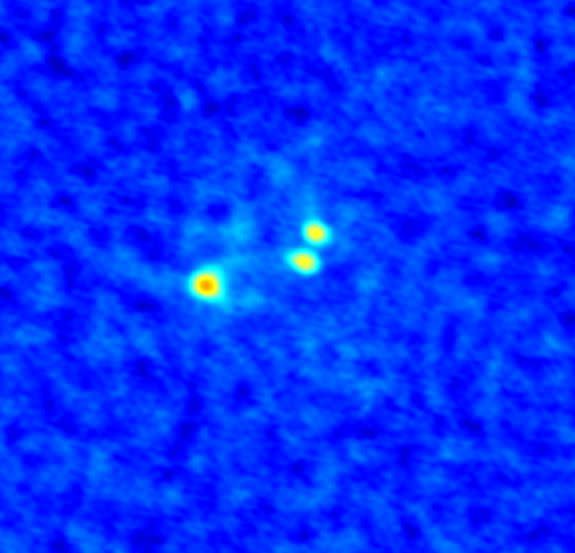This is the baby photo of three stars forming 750 light-years from Earth

In a distant part of space, 750 light-years from Earth, three young stars are being born together while scientists are watching.
Researchers think that stars condense out of clouds of dust and gas in various parts of space, and a new study in the journal Nature details what scientists have learned about the three nascent stars developing closely together in the L1448 IRS3B system.
SEE ALSO: The first photo of Earth from space was taken 70 years ago
"We've seen three stars forming together, but they were all farther apart," study author John Tobin told Mashable in an interview.
"These three stars are all living in the same house, essentially."
A photo taken by the powerful Atacama Large Millimeter/submillimeter (ALMA) Array observatory in Chile clearly shows the star trio swirling with one another in a disk of gas and dust.
The star system as a whole is probably about 150,000 years old, which, in cosmic terms, means that these are baby stars just getting their cosmic footing in a big universe.
The bright star that appears to be circling the other two in the center of the system is thought to be the youngest, at only about 10,000 to 20,000 years old, Tobin said. It's also the least massive, with far less material within it than the sun, he added.

Image: John Tobin from data obtained with the VLA telescope
On the whole, the entire L1448 IRS3B system is about eight times larger than our own solar system.
"This complicated structure was revealed thanks to the ten times higher sensitivity and two times higher resolution provided by ALMA compared with previous observations," astronomer Adele Plunkett, who is unaffiliated with the new research, wrote in an analysis of the finding for Nature.
Previous research has shown that about 50 percent of all stars like the sun are born with some kind of stellar companion.
Learning more about the formation of this multi-star system could help scientists figure out how these multi-star systems form in general. This would give us a fuller picture of the diversity of stars and worlds in our galaxy and beyond.
Scientists think that a spread out system of stars forms when a large cloud of dust and gas "fragments" into concentrated areas of material that can then become gravitationally unstable and collapse. Those dense parts of the larger cloud collect more and more matter until the pressure and temperature become so great that it kicks off thermonuclear reactions, and a star is born.
Previous research appears to lend credence to that idea, but this week's study provides direct evidence that stars which are more closely bound in a system form when a smaller disk around a baby star is fragmented.
“Now, we’ve seen this disk fragmentation at work,” Tobin said in a statement.
“We now expect to find other examples of this process and hope to learn just how much it contributes to the population of multiple stars."
